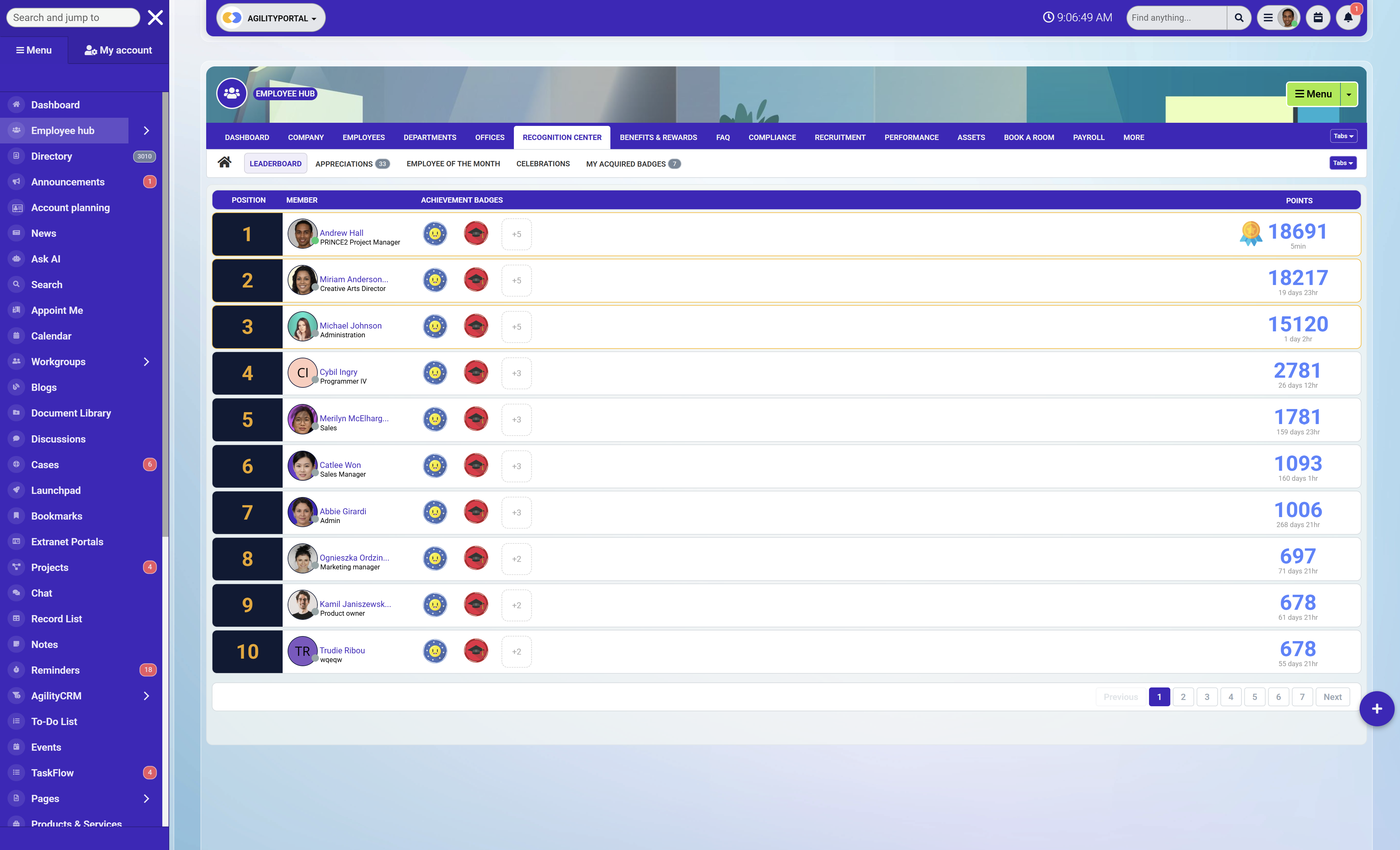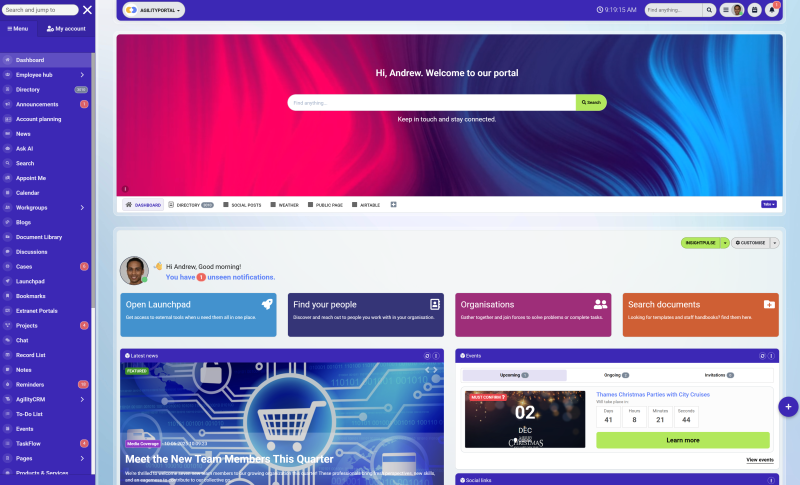Insight Blog
Agility’s perspectives on transforming the employee's experience throughout remote transformation using connected enterprise tools.
14 minutes reading time
(2824 words)
Featured
7 Signs You Need to Invest More Effort into Internal Communications Campaigns - UPDATED 2025 – A Complete Guide
7 Signs You Need to Invest More Effort into Internal Communications Campaigns - UPDATED 2025 – A Complete Guide
How will you know if your internal communication strategy is successful? 7 Signs You Need to Invest More Effort into Internal Communications Campaigns.
It's incredible to imagine that there are still companies that undervalue or ignore internal communications. Unfortunately, such companies do exist. As a result, their businesses are likely to suffer.
Internal communication is concerned with facilitating effective communication among employees within a company. It includes creating and distributing messages and campaigns on behalf of management, as well as fostering communication with the organization's constituents.
This could range from announcing a new policy or telling people about an upcoming event to performing an organization-wide engagement or culture audit. Internal communication is typically handled by the HR department, marketing, or public relations departments; however, it may be handled by any and all divisions within an organization.
Here are a few common types as:
- Crisis communication
- Leadership and top-down comms
- Change communication
- Crisis communication
- Information comms
- Campaign comms
- Vertical communication
- Peer communication
- Culture comms
- Campaign comms
How to assess internal communication campaigns
You need to be aware of your organization type to select the indicators for assessment. What does success entail for your organization? Whatever it is, it specifies what data you need to track and how these aids in performance measurement.
Staff retention, employee engagement, productivity rates, and other factors may have a demonstrable, tangible impact on strategic objectives for some. However, it may vary based on the size and development of your company. You can use the following indicators to know why you need to invest more effort into internal communications campaigns:
1. Your Employees Are No Longer Engaged in Their Work
When employees start losing interest in their work, it's a red flag that something deeper is going wrong. Morale drops, productivity slows, and turnover rises — all of which can cost your business more than you realize.
While it's easy to blame external factors like the economy or upper management, the root cause often lies within your internal communication strategy. When employees feel disconnected, unheard, or out of the loop, engagement naturally declines.
Common Signs to Watch For:
- Lack of enthusiasm or motivation in daily tasks
- Decline in productivity or missed deadlines
- Increase in absenteeism or quiet quitting
- Higher employee turnover rates
- Minimal participation in meetings or discussions
Improving employee engagement starts with better communication. A platform likeinternal communication helps bridge those gaps by centralizing news, feedback, and team updates — ensuring everyone feels informed, connected, and valued.
2. Your Employees Are Disconnected
You're about to launch a nationwide campaign — but half your branches have no idea what message they're supposed to deliver. Or maybe you find out that most of your front-desk team doesn't even know about your latest rewards program. Worse yet, a customer complains that your staff isn't following the new sustainability procedures you shared last week.
If this sounds familiar, you're facing a communication breakdown. The information exists — it's just not reaching the right people at the right time. Disconnected employees can't deliver a consistent brand message or customer experience.
What This Looks Like in Practice:
- Key updates don't reach frontline teams
- Company goals are unclear across departments
- Customer-facing employees share outdated information
- Campaigns lose impact due to inconsistent execution
To fix this, you need more than mass emails — you need an employee communication platform like AgilityPortal. It ensures everyone, from head office to the front line, receives timely updates, resources, and training through one connected digital workplace.
3. You're Still Using a Top-Down Communication Approach
Be honest — how effective is your internal communication strategy really? Maybe your head office sends a monthly newsletter to all locations, or a weekly update about new promotions. But if that information only reaches frontline managers (and never makes it to the employees actually speaking with customers), then your communication model is broken.
Research shows that 74% of employees feel they're missing out on company news and updates, according to a Gallup workplace study. Even worse, only 13% of frontline workers say their company communicates effectively across all levels. That lack of connection creates confusion, slows productivity, and damages customer experience.
A purely top-down communication approach limits feedback, disengages employees, and prevents collaboration. Instead of communication flowing both ways, it stops at management — leaving the people who represent your brand uninformed and uninspired.
Warning Signs of Poor Communication Flow:
- Frontline employees hear about company updates through customers or social media
- Managers act as bottlenecks for critical information
- Staff feels unheard, with no channel for feedback or ideas
- Campaigns lose impact due to inconsistent messaging
To solve this, organizations need a two-way communication platform like AgilityPortal — where leadership can share updates instantly while employees can respond, ask questions, and contribute ideas. It transforms communication from a one-way announcement into an active dialogue that builds alignment, trust, and engagement across every level of your business.
4. Complaints from Customers
If your customers are unhappy, it's often a reflection of what's happening behind the scenes. A better customer experience starts with a better employee experience — and when communication inside your organization breaks down, it almost always shows up in the customer journey.
Studies consistently prove the link between engagement and satisfaction. According to Gallup, companies with highly engaged employees see a 10% boost in customer loyalty and a 20% increase in sales performance compared to those with poor communication and disengaged teams.
So, when customer complaints start rising, it's rarely just about the product or service. More often, it's about miscommunication, unclear expectations, or a lack of alignment between teams.
What This Might Look Like:
- Inconsistent service or messaging across different locations
- Employees unaware of updated procedures or product details
- Missed opportunities to resolve issues quickly due to poor communication
- Customers feeling frustrated by inconsistent or uninformed responses
By improving internal communication with AgilityPortal, your teams can stay informed, aligned, and connected. When employees have the tools, updates, and confidence they need to deliver great service, your customers will notice the difference — and your brand reputation will grow stronger as a result.
5. Are Your Employees Actually Seeing Your Messages?
You might think you're communicating effectively — sending updates every morning at 9 a.m., posting announcements on the intranet, or blasting company-wide emails. But here's the reality: most employees never see those updates when it matters most.
According to Gallup, only 28% of employees strongly agree that their organization's internal communication keeps them informed about what's going on. Many messages are buried under notifications, sent at the wrong time, or delivered through channels employees rarely check during their shifts.
When communication is one-directional and time-sensitive, engagement drops dramatically. If employees read your updates only after hours, they're less likely to absorb or act on them — meaning vital business information is lost in the noise.
Why Messages Go Unread:
- Updates sent during peak working hours get overlooked
- Intranets are static and not optimized for mobile use
- Emails pile up, making important news easy to miss
- Employees don't receive personalized or relevant alerts
To boost visibility and engagement, organizations need smart communication tools that reach people where they already work.
With AgilityPortal, updates can be delivered instantly through push notifications, chat channels, or mobile alerts — ensuring employees see critical information in real time, no matter where they are.
6. Information Isn't Easily Accessible
If your employees have to dig through endless folders, emails, or outdated systems just to find a single file — your internal knowledge management is broken. Information should be centralized, searchable, and instantly available when and where your teams need it.
When data is scattered across different tools or stored inconsistently, productivity suffers, mistakes increase, and employee frustration skyrockets. In short, information silos kill efficiency.
Real-World Examples:
- A marketing team can't find the latest brand assets because they're buried in old email threads.
- A new hire wastes an hour searching three different systems for the onboarding checklist.
- A frontline employee gives a customer the wrong price because the updated product sheet was never uploaded to the shared drive.
Common Warning Signs:
- Employees rely on coworkers instead of documented resources
- Files live across multiple platforms (email, SharePoint, Google Drive, etc.)
- Time wasted searching for the "right version" of a document
- Duplication of work because information isn't shared company-wide
The solution is a centralized digital workplace — like AgilityPortal — where all your company documents, FAQs, forms, and resources live in one organized, searchable hub. Employees can access the latest information instantly from any device, ensuring accuracy, transparency, and faster decision-making across the organization.
7. There is no direct information sharing channel
Let's say one of your stores in the Midwest comes up with a wonderful way to increase loyalty program sign-ups.
Alternatively, a team that changes up the upsell display at cash sees a 10% increase in sales.
These are wonderful suggestions that other teams could implement, but only if they were aware of them.
How to run successful internal marketing campaign examples
Adding color and brightness to your internal communications is critical. Especially if the target demographic works from home and is more difficult to reach than usual.
This segment of your staff requires more powerful communications in order to reintegrate them into the organization.
1. Using Mentions to Boost Connection and Recognition
Everyone loves a little recognition — especially when working remotely or across different locations. One of the simplest yet most powerful features of a modern internal communication platform is the ability to @mention colleagues directly in posts, comments, or updates.
This small action has a big impact. It makes communication more personal, engaging, and inclusive, allowing team members to connect and celebrate each other's contributions in real time.
Imagine this:
- A marketing lead @mentions a designer to highlight their creative work on a campaign.
- A project manager @mentions remote team members to thank them for meeting a tight deadline.
- An HR manager @mentions a new hire in the company feed to introduce them to everyone.
Each mention instantly notifies the tagged person, creating a moment of visibility and appreciation. Even better, others in the company can join the conversation — reacting, commenting, and engaging — building a stronger sense of community and connection.
With tools like AgilityPortal, you can use mentions to:
- Celebrate team wins and recognize individual contributions
- Bring remote workers into everyday conversations
- Encourage collaboration between departments and offices
- Humanize company-wide communication and boost morale
These social intranet features turn simple updates into meaningful interactions — helping employees feel seen, valued, and part of something bigger, no matter where they're working from.
2. Use Gamification to Drive Engagement
Gamification isn't just about fun — it's a proven way to motivate employees, encourage participation, and reduce resistance to new initiatives. By introducing game-like elements such as points, badges, leaderboards, and rewards, organizations can turn everyday tasks into exciting challenges that spark healthy competition and team pride.
For example, a sales leaderboard that tracks performance across all regional offices can fuel motivation and recognize top achievers in real time. Departments can even compete in friendly challenges — such as "Team of the Month" or "Innovation League" — with updates and results posted directly on the company intranet for everyone to see.
This approach creates a sense of momentum, encouraging employees to log in, cheer on their peers, and stay connected. Recognition becomes visible, engagement increases, and company culture grows stronger as people work toward shared goals.
How Gamification Helps Your Business:
- Boosts motivation and performance through healthy competition
- Encourages continuous learning and skill development
- Strengthens team collaboration and cross-department engagement
- Increases daily logins and participation in the digital workplace
You can easily integrate gamification into your digital workplace — creating leaderboards, awarding digital badges, and tracking achievements to make work more rewarding, interactive, and engaging.
3. Using Hashtags in Your Intranet's Social Portal
Hashtags aren't just for social media anymore — they're becoming an essential part of modern intranet communication. Within your company's internal network, hashtags help organize conversations, connect people around shared interests, and make content easier to find.
Think of them as digital signposts. When someone uses a hashtag like #WellnessWeek, #NewProductLaunch, or #TeamRecognition, employees across different departments can instantly join the discussion, share updates, or celebrate achievements — all under one searchable tag.
In innovative platforms like AgilityPortal, hashtags can be used to:
- Promote internal communication campaigns (e.g., #SustainabilityChallenge or #CustomerFirst)
- Encourage participation in company events or training sessions
- Group related posts, articles, and project updates for easier access
- Boost visibility for key initiatives and community-driven topics
By using intranet hashtags, you make your internal communications feel more social, connected, and engaging. They turn static announcements into interactive conversations — helping employees stay aligned, informed, and part of the bigger company story.
You can use hashtags features in innovative intranets like AgilityPortal.
4. Use Video to Strengthen Communication and Engagement
In today's fast-paced digital workplace, effective communication can be a real challenge — especially when employees have limited time and attention. That's why video has become one of the most powerful ways to connect, engage, and inspire your teams.
Whether you're launching a new campaign, promoting an idea, or sharing a project update, video helps bring your message to life. It's more personal, more engaging, and easier to digest than long text posts or email updates. In fact, studies show that blog posts containing video attract three times more inbound links than those without — proving just how impactful visual communication can be.
With VidConnect by AgilityPortal, you can take this a step further. VidConnect is your organization's built-in video conferencing and collaboration tool — the perfect answer to Zoom — designed to keep all internal communication secure, centralized, and accessible right inside your intranet.
Teams can host virtual meetings, record video updates, or stream internal events directly within the platform — without switching between apps.
How Video and VidConnect Enhance Communication:
- Makes company messages more human and relatable
- Encourages engagement through visual storytelling
- Keeps remote and hybrid employees connected face-to-face
- Simplifies collaboration with built-in video calls and recordings
- Strengthens internal culture through authentic, transparent communication
By integrating video directly into your digital workplace, AgilityPortal helps you bridge the gap between written updates and real human connection — all while maintaining the security and structure of your internal communication ecosystem.
5. Use Announcements to Power Internal Campaigns
Every successful organization knows that great communication fuels great results — and announcements are one of the simplest yet most effective ways to deliver important updates, inspire action, and drive participation across your teams.
Whether you're launching a new internal campaign, celebrating a company milestone, or promoting a sustainability initiative, announcements help keep everyone aligned and informed. They act as digital billboards within your intranet — ensuring that key messages don't get buried in emails or chat threads.
Imagine using announcements to:
- Kick off an employee wellness challenge or volunteer event
- Share progress on a company-wide initiative like diversity or sustainability
- Celebrate a sales milestone or team achievement
- Promote new learning modules or product launches
With AgilityPortal, announcements can be pinned to the homepage, targeted to specific departments or regions, and even scheduled in advance. You can add videos, images, and links to make them more dynamic and engaging — turning ordinary updates into high-impact internal campaigns.
Why It Works:
- Delivers key messages instantly to the right audience
- Increases visibility for important company news
- Encourages interaction through comments and reactions
- Builds transparency and keeps everyone in the loop
By using announcements strategically, organizations can transform everyday communication into moments that motivate, engage, and connect employees — all from one secure, centralized platform powered by AgilityPortal.
Book a demo for more information
Unify your workplace by connecting all your favorite tools in one powerful digital hub.
With AgilityPortal, you can integrate Microsoft 365, HR systems, social media channels, and third-party business apps — so your teams never waste time searching across platforms again.
- Seamless Microsoft 365 Integration: Collaborate effortlessly with Teams, SharePoint, and Outlook built right into your workspace.
- Unified Search: Instantly find files, messages, and data — even from third-party systems — using one smart search bar.
- Connected Employee Profiles: Pull in key HR details so everyone can access the information they need in seconds.
- Social & External Feeds: Bring your company's voice to life by integrating social media posts and external news directly into your intranet.
- Multi-Channel Publishing: Share announcements and updates across multiple platforms — including digital signage and Microsoft Teams — with one click.
With AgilityPortal, your tools finally work together, not separately — creating a seamless, connected, and informed digital workplace where collaboration thrives and productivity skyrockets.
Categories
Blog
(2600)
Business Management
(319)
Employee Engagement
(207)
Digital Transformation
(173)
Intranets
(119)
Growth
(118)
Remote Work
(61)
Sales
(48)
Collaboration
(37)
Culture
(29)
Project management
(29)
Customer Experience
(26)
Knowledge Management
(21)
Leadership
(20)
Comparisons
(5)
Ready to learn more? 👍
One platform to optimize, manage and track all of your teams. Your new digital workplace is a click away. 🚀
Free for 14 days, no credit card required.



















